

TheRandomLab. TheRandomLab. Getting Started with Kinect and Processing. So, you want to use the Kinect in Processing.

Great. This page will serve to document the current state of my Processing Kinect library, with some tips and info. The current state of affairs Since the kinect launched in November 2010, there have been several models released. Here's a quick list of what is out there and what is supported in Processing for Mac OS X. Kinect 1414: This is the original kinect and works with the library documented on this page in Processing 2.1 Kinect 1473: This looks identical to the 1414, but is an updated model. Now, before you proceed, you could also consider using the SimpleOpenNI library and read Greg Borenstein’s Making Things See book. I’m ready to get started right now What hardware do I need? First you need a “stand-alone” kinect (model 1414 only for now!). Standalone Kinect Sensor If you have a previous kinect that came with an XBox, it will not include the USB adapter. Getting Started with Kinect and Processing. Getting Started with Kinect and Processing. PCL - Point Cloud Library (PCL)
PCL - Point Cloud Library (PCL) Simple-openni - OpenNI library for Processing. This project is a simple OpenNI and NITE wrapper for Processing.
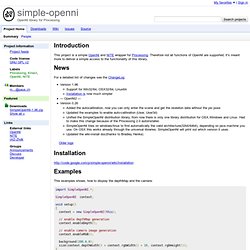
Therefore not all functions of OpenNI are supported, it's meant more to deliver a simple access to the functionality of this library. For a detailed list of changes see the ChangeLog Version 1.96 Support for Win32/64, OSX32/64, Linux64 Installation is now much simpler --- OpenNI2 --- Version 0.26 Added the autocalibration, now you can only enter the scene and get the skeleton data without the psi pose Updated the examples to enable auto-calibration (User, User3d) Unified the SimpleOpenNI distribution library, from now there is only one library distribution for OSX,Windows and Linux. Had to make this change because of the Processing 2.0 autoinstaller. SimpleOpenNI tries on windows/linux to find automatically the valid architecture(32bit/64bit), depending on java machine you use. Older logs This examples shows, how to display the depthMap and the camera: import SimpleOpenNI SimpleOpenNI context; Simple-openni - OpenNI library for Processing. Kinect. Free Software, SDKs & Open Source.
Kinect Physics Tutorial for Processing. Kinect Physics Tutorial for Processing. L@Bx hackerspace in Bordeaux. Qu’est que la Kinect ?
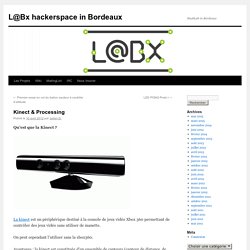
La kinect est un périphérique destiné à la console de jeux vidéo Xbox 360 permettant de contrôler des jeux vidéo sans utiliser de manette. On peut cependant l’utiliser sans la xbox360. Avantages : la kinect est constituée d’un ensemble de capteurs (capteur de distance, de profondeur, une webcam classique, une webcam infra-rouge pour detecter dans le noir, detection de squelette(s) ) qui sont moins onéreux est plus rapides à mettre en place qu’en réalisant un protoype electronique DIY. Elle nécessite une alimentation secteur et se branche sur l’ordinateur par prise USB. Détails et emplacements des différents capteurs de la Kinect Caractéristiques techniques : L@Bx hackerspace in Bordeaux. Kinect for Processing Library. Updates 05/07/2014 – The library is renamed again to Kinect4WinSDK in order not to use the prefix P or P5.
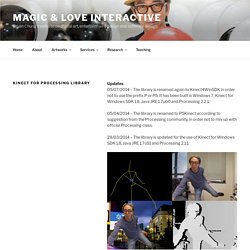
It has been built in Windows 7, Kinect for Windows SDK 1.8, Java JRE 1.7u60 and Processing 2.2.1. 05/04/2014 – The library is renamed to P5Kinect according to suggestion from the Processing community, in order not to mix up with official Processing class. 28/03/2014 – The library is updated for the use of Kinect for Windows SDK 1.8, Java JRE 1.7u51 and Processing 2.1.1. Introduction The Kinect for Processing library is a Java wrapper of the Kinect for Windows SDK. Obtain the RGB image from the Kinect camera.Obtain the depth image from the Kinect camera.Align the RGB image with the depth image.Obtain player and skeleton information.
API description GetImage() returns a 640 x 480 ARGB PImage. GetDepth() returns a 640 x 480 ARGB PImage. GetMask() returns a 640 x 480 ARGB PImage. Skeleton tracking is a bit complicated. Please note that a new figure may not represent a real new human player. Kinect for Processing Library. Kinect + Processing : image des profondeurs (depthImage) Interaction Design tags : Kinect • Processing Nous allons, dans cet article, nous intéresser à la fonction depthImage de la Kinect.
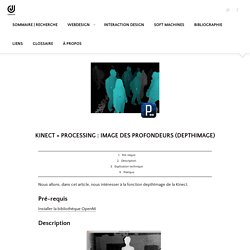
Pré-requis Installer la bibliothèque OpenNI Description La Kinect utilise un projecteur et une camera infrarouge pour produire une image représentant les différentes profondeurs de la scène qu’elle capte. Kinect + Processing : image des profondeurs (depthImage) Experiments in Open Source + After Effects. Experiments in Open Source + After Effects. Kinect Hacking using Processing. About Processing from Processing.org: Processing is an open source programming language and environment for people who want to create images, animations, and interactions.
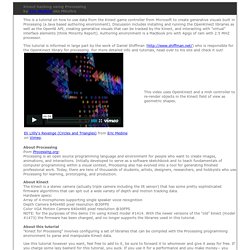
Initially developed to serve as a software sketchbook and to teach fundamentals of computer programming within a visual context, Processing also has evolved into a tool for generating finished professional work. Today, there are tens of thousands of students, artists, designers, researchers, and hobbyists who use Processing for learning, prototyping, and production. About Kinect The Kinect is a stereo camera (actually triple camera including the IR sensor) that has some pretty sophisticated firmware algorithms that can spit out a wide variety of depth and motion tracking data.
An open source implementation of KinectFusion - Point Cloud Library.